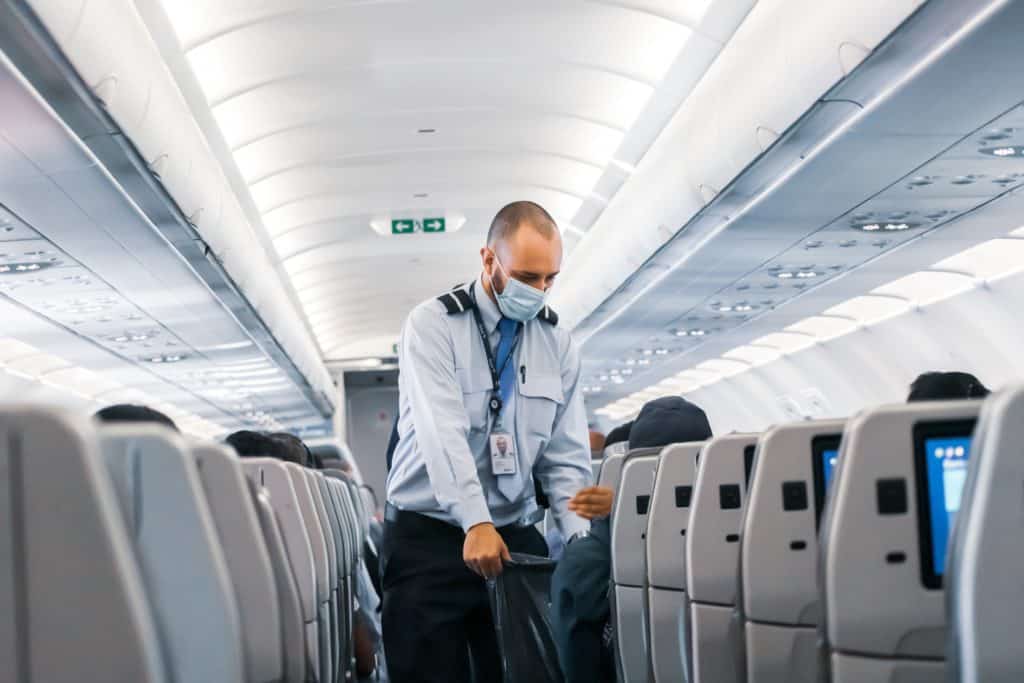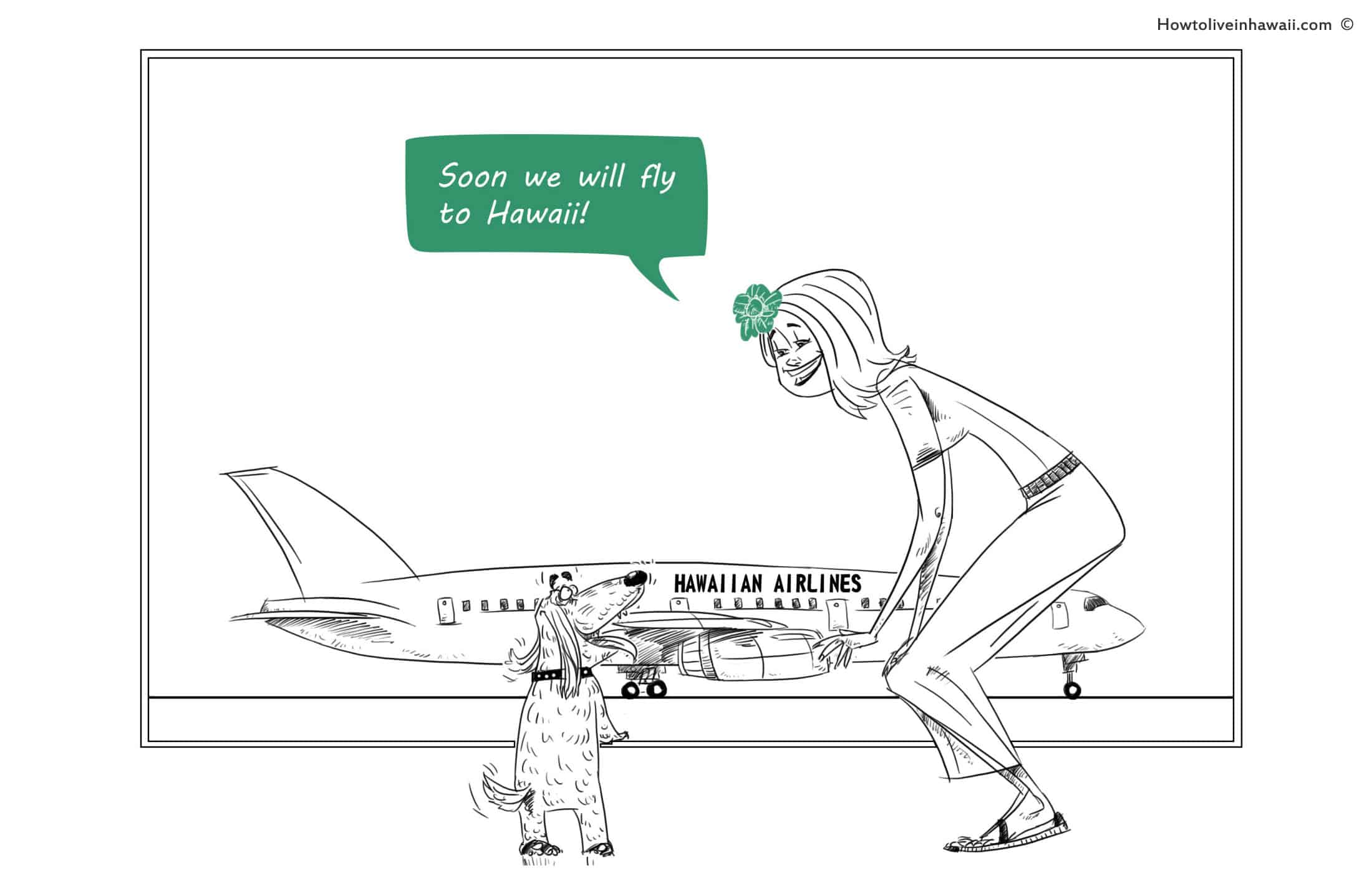Step 1: Prohibited Animals
Step 2: Vaccinations
Step 3: Microchip
Step 4: Blood Test
Bringing pets to Hawaii can be tricky but with the appropriate considerations, it can be made much simpler!
In this post, I’ll touch on booking a flight to Hawaii with your pets, and some things to consider when flying to Hawaii with your pet.

Where Does My Pet Go on the Flight to Hawaii?
Unless your pet is a guide dog or service dog, it will probably have to travel to Hawaii in the baggage compartment or cargo hold of an airplane.
I have yet to find a commercial airline that allows pets to fly in the passenger cabin on flights to Hawaii.
Alaska Airlines is the only commercial airline I have found that allows pets (small cats & dogs only) to fly in the passenger cabin on flights to Hawaii.
I’ve even looked into commercial cruise lines, and Cunard is the only one I’ve found that accepts pets as passengers, but only on transatlantic crossings.
If your pet is too big to fly in the passenger cabin on an Alaska Airlines flight, I’ve come across only two other ways to avoid shipping your pet to Hawaii in a plane’s baggage or cargo hold, and both options are prohibitively expensive:
- Charter a private flight or private cruise to Hawaii.
- Book a flight to Hawaii with a Pet Travel Company, which lets your dog (and sometimes your cat) ride in the passenger cabin with you. Dogs are also allowed outside of their crates during the flight. Cost: $3500 to $12,000 per passenger (you and your pet count as 2 passengers).
Most of us can’t afford those alternatives and will have to use a commercial airline. But there are ways to minimize the risk and discomfort to your pet during its flight.

Bringing Pets to Hawaii: Things to Do Before Your Flight
Read the airline’s rules before booking your flight to Hawaii
Each airline has different rules when it comes to pets, and not all airline agents are well-versed in these rules, so you must do your homework. Be prepared to read a lot of fine print and take notes.
Sometimes it can be difficult to find the pet information on an airline’s website by browsing — in this case, it may be easier to type the airline’s name plus the word “pets” into a search engine to find the relevant webpages.
If the airline you’re thinking of using has very little information about pets on their website, I’d think twice about using them. Some airlines are more pet-friendly than others. Here are the pet rules of some commonly used airlines:
- Aer Lingus
- Air Canada
- Air France
- Air New Zealand
- AirTran Airways
- Alaska Airlines
- Alitalia: Pets Info, Domestic Flights
- All Nippon Airways (ANA): Traveling With Pets, Pet FAQs
- American Airlines: Traveling With Pets, Unaccompanied Pets As Cargo
- British Airways
- Cathay Pacific
- Continental Airlines
- Delta Airlines: Pet Travel Information, Pet Travel FAQs
- Frontier Airlines
- Hawaiian Airlines: Traveling With Your Pet, Check-In Pets As Baggage, Acceptance Of Live Animals, Unaccompanied Pets As CargoIsland Air
- Japan Airlines (JAL): Domestic Flights; International Flights – Japanese, English; Unaccompanied Pets As Cargo
- JetBlue: Traveling With Pets, Pets On International Flights
- KLM Royal Dutch Airlines
- Korean Air
- Lufthansa
- Philippine Airlines
- Qantas: Travelling With Pets, Service Dogs
- Singapore Airlines
- Southwest Airlines: Pet Policy, Pet FAQs
- Spirit Airlines
- Ted/United Airlines: Traveling With Pets, Travel To Hawaii, Kennels, Unaccompanied Pets As Cargo
- US Airways
- Virgin America: Pets Info, Service Animals, Service Animals In Training
- Virgin Atlantic: Travelling With Pets, Assistance Dogs
Review the track record of the airline you’re thinking of using
Each month, U.S.-based airlines are required by law to report any losses, injuries, or deaths of animals on their flights. Here is a compilation of animal “incidents” reported between 2005-2011.
Keep in mind that major airlines are always going to have more incidents than smaller airlines, simply because they have more animals passengers. For this reason, it’s probably best to compare major airlines only with other major airlines, and smaller airlines with other smaller airlines.
Click the name of an airline to see details of the incidents reported. As you read these statistics, you might want to pay more attention to the number of injuries and deaths than the number of losses, as losses are usually due to a poorly secured kennel, and this is almost always preventible.
(In my next post in this series, I will tell you how to make sure a kennel is escape-proof.)
Consider if your pet is a brachycephalic (short-nosed) dog or cat
Animals such as a pug, bulldog, or Persian cat — you should be aware that the Humane Society of the United States says these breeds should never be shipped in the cargo hold of a plane.
Perhaps this stance is overly cautious, perhaps not. You are the best judge of which traveling conditions your pet is able and unable to tolerate.
Ship your pet in the baggage/cargo hold only if there’s no other alternative, and avoid traveling during warm weather, as short-nosed pets overheat easily.
Travel during the coolest months of the year, and if possible, travel early in the morning or late at night. If your journey will consist of more than one flight and your pet is allowed to ride in the passenger cabin on any flights before the flight to Hawaii, ask your airline(s) if it’s OK if your pet switches from an under-seat kennel to a baggage/cargo kennel mid-journey.
Airlines usually have special rules regarding Brachycephalic breeds, so be on the lookout for those when reading over their pet rules.
Book with an airline agent
Book your flight with an airline agent, not online. It’s fine to find the flight you want through online methods, but when it’s time to make the flight reservation, call the airline.
Only a certain number of pets are allowed on each flight, and speaking to an agent is probably the only way you’ll be able to reserve one of those spots for your pet on the flight you want. Be sure you’ve read the airline’s pet rules before you call.
If you get the feeling that the agent you’re speaking to doesn’t know the rules very well, call back and speak to another agent.
Book with your pet’s eligibility date in mind
Book a flight that arrives in Hawaii no earlier than your pet’s eligibility date. At the end of Step 4, you should have found out from the Department of Agriculture your pet’s “5-Day-or-Less Eligibility Date” — in other words, the earliest date you can bring your pet to Hawaii without having your pet quarantined.
Make every effort you can to avoid having your pet arrive in Hawaii before that date. If you must quarantine your pet, try to keep its quarantine time to 30 days or less.
In her books “So You Want To Live In Hawaii” and “The Hawaii Pet Book,” author Toni Polancy says she’s found — from talking to pet owners about their quarantine experiences — that pets quarantined for 30 days or less seemed to tolerate their confinement pretty well, while those quarantined for longer than 30 days were more likely to show signs of psychological trauma.
Make sure your flight is non-stop
Book a nonstop flight to your final destination in Hawaii.
If this is absolutely impossible, book the route that will get your pet to its final destination in the shortest amount of time.
Your first priority should be to minimize the amount of time your pet must spend in the baggage or cargo hold of a plane.
If your pet is allowed to ride in the passenger cabin on any flights before the flight to Hawaii, ask your airline(s) if it’s OK if your pet switches from an under-seat kennel to a baggage/cargo kennel mid-journey.
Consider your final destination
- If your final destination is the Big Island, book your flight to Kona Airport so you can use their direct-release program (rather than Honolulu Airport’s). Hilo Airport does not have a direct-release program.
- If your final destination is Maui, book your flight to Kahului Airport so you can use their direct-release program (rather than Honolulu Airport’s).
- If your final destination is Kauai, book your flight to Lihue Airport so you can use their direct-release program (rather than Honolulu Airport’s).
- If your final destination is Kona Airport (Big Island), Kahului Airport (Maui), or Lihue Airport (Kauai), make sure the airline you want to use participates in the neighbor island dog/cat entry program so your pet can be released directly after its flight there. Before booking your flight, make sure a local inspector will be available to process your pet’s direct release on the date/time of the flight’s arrival. Call to make a reservation for a pet inspection with one of the following contractors:
- Kona Airport
- Kona Veterinary Service: (808) 325-6637
- Keauhou Veterinary Hospital: (808) 322-2988
- Kahului Airport
- Central Maui Animal Clinic: (808) 893-2380
- Maui Humane Society: (808) 877-3680
- South Shore Veterinary Care: (808) 874-3422
- Lihue Airport
- Kauai Humane Society: (808) 632-0610
- Kona Airport
- If your final destination is Oahu, Molokai, or Lanai, try to book a flight to Honolulu that arrives no later than 3pm (2pm if it’s an international flight). This will ensure that there will be sufficient time for the airline to transport your pet to the airport’s quarantine holding facility by 4:30pm. If your pet arrives after 4:30pm, it won’t be released until the following day.
- If your final destination is Molokai or Lanai, allow at least 4 hours between your arrival at Honolulu Airport and the departure of your connecting flight to Molokai or Lanai. This will allow for possible delays as your pet goes through the entire direct-release process at Honolulu Airport.
- If your pet will be coming from outside the U.S., make sure your pet’s flight will arrive during U.S. Customs’ hours of operation to avoid possible delays in your pet’s processing.
- If your pet will be coming to Hawaii from Guam, Australia, New Zealand, or the British Isles, your pet must not leave its country of origin during the six months prior to its flight to Hawaii (except to travel to Guam, Australia, New Zealand, the British Isles, or Hawaii). Choose the date of your flight accordingly.
- If you won’t be traveling with your pet, you must tell the airline so they can list a consignee (the only person whom the airline will be allowed to release your pet to) on the shipmaster’s declaration.
- Avoid traveling during the hottest & coldest times of year. The U.S. Department of Agriculture’s Animal-Plant Health Inspection Service will not allow pets to be checked as baggage if they will be exposed to temperatures higher than 85 degrees (Fahrenheit) or lower than 45 degrees (Fahrenheit) for more than 45 minutes. For this reason, many airlines institute summer and winter “embargoes” during which they do not allow pets to fly in the baggage or cargo hold. A notable example is Hawaiian Airlines, which will not accept pets as checked baggage from April 15 through October 15. A reader told me that a Hawaiian Airlines agent told her that this rule applies only to flights originating from Sacramento, Phoenix, Las Vegas, and San Jose. You should double-check this if you’re booking a Hawaiian Airlines flight, as those cities are not listed in the rule on Hawaiian Airline’s website.
- At least 1 month before your pet’s scheduled flight(s), call the airline(s) to confirm your pet’s reservation(s).
Step 6: Kennel
Step 7: Import Form
Step 8: Health Certificate
Step 9: Flight Prep
Step 10: Moving Day

